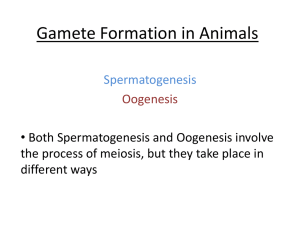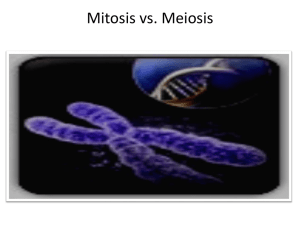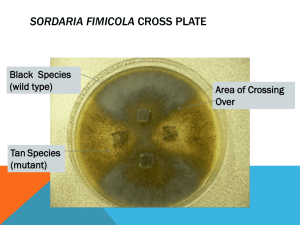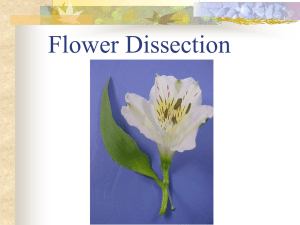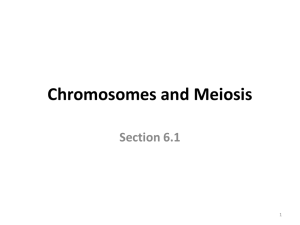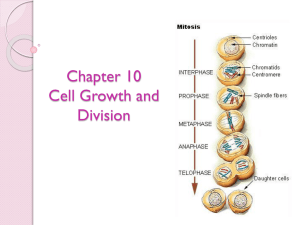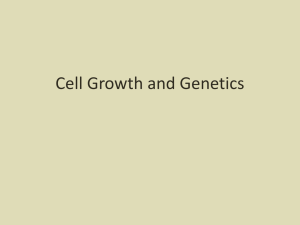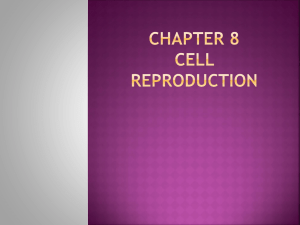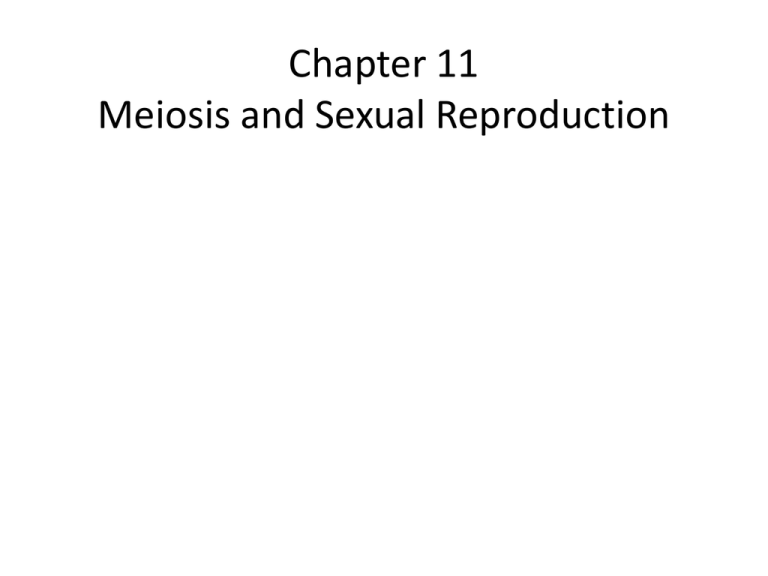
Chapter 11
Meiosis and Sexual Reproduction
Section 1: Reproduction
Preview
•
•
•
•
Asexual Reproduction
Sexual Reproduction
Chromosome Numbers
Summary
Asexual Reproduction
• In asexual reproduction, a single parent passes a complete
copy of its genetic information to each of its offspring.
• An individual formed by asexual reproduction is genetically
identical to its parent.
• Prokaryotes reproduce asexually by a kind of cell division
called binary fission.
• Many unicellular eukaryotes also reproduce asexually.
Asexual Reproduction, continued
• Some multicellular eukaryotes, such as starfish, go through
fragmentation.
• Fragmentation is a kind of reproduction in which the body
breaks into several pieces. Some or all of these fragments
regrow missing parts and develop into complete adults.
Asexual Reproduction, continued
• Other animals, such as the hydra, go through budding. In
budding, new individuals split off from existing ones.
• Some plants, such as potatoes, can form whole new plants
from parts of stems.
• Other plants can reproduce from roots or leaves.
• Some crustaceans, such as water fleas, reproduce by
parthenogenesis. Parthenogenesis is a process in which a
female makes a viable egg that grows into an adult without
being fertilized by a male.
Sexual Reproduction
• Most eukaryotic organisms reproduce sexually.
• In sexual reproduction, two parents give genetic material to
produce offspring that are genetically different from their
parents.
• Each parent produces a reproductive cell, called a gamete. A
gamete from one parent fuses with a gamete from the other.
Visual Concept: Sexual Reproduction
Sexual Reproduction, continued
• The resulting cell, called a zygote, has a combination of
genetic material from both parents. This process is called
fertilization.
• Because both parents give genetic material, the offspring has
traits of both parents but is not exactly like either parent.
Visual Concept: Fertilization
Sexual Reproduction, continued
Germ Cells and Somatic Cells
• The cells of a multicellular organism are often specialized for
certain functions.
• Cells that are specialized for sexual reproduction are called
germ cells. Only germ cells can produce gametes.
• Other body cells are called somatic cells. Somatic cells do not
participate in sexual reproduction.
Sexual Reproduction, continued
Advantages of Sexual Reproduction
• Asexual reproduction is the simplest, most efficient method of
reproduction.
• Asexual reproduction allows organisms to produce many
offspring in a short period of time without using energy to
make gametes or to find a mate.
• But the genetic material of these organisms varies little
between individuals, so they may be at a disadvantage in a
changing environment.
Sexual Reproduction, continued
Advantages of Sexual Reproduction
• Sexual reproduction, in contrast, produces genetically diverse
individuals.
• A population of diverse organisms is more likely to have some
individuals that survive a major environmental change.
Chromosome Number
• Each chromosome has thousands of genes that play an
important role in determining how an organism develops and
functions.
• Each species has a characteristic number of chromosomes.
• An organism must have exactly the right number of
chromosomes. If an organism has too many or too few
chromosomes, the organism may not develop and function
properly.
Visual Concepts: Chromosome
Number
Click above to play the video.
Chromosome Number, continued
Haploid and Diploid Cells
• A cell, such as a somatic cell, that has two sets of
chromosomes is diploid.
• A cell is haploid if it has one set of chromosomes.
• Gametes are haploid cells.
Chromosome Number, continued
Haploid and Diploid Cells
• The symbol n is used to represent the number of
chromosomes in one set.
• Human gametes have 23 chromosomes, so n = 23. The diploid
number in somatic cells is written as 2n. Human somatic cells
have 46 chromosomes (2n = 46).
Visual Concept: Comparing Haploid
and Diploid Cells
Click above to play the video.
Chromosome Number, continued
Homologous Chromosomes
• Each diploid cell has pairs of chromosomes made up of two
homologous chromosomes.
• Homologous chromosomes are chromosomes that are similar
in size, in shape, and in kinds of genes.
• Each chromosome in a homologous pair comes from one of
the two parents.
• Homologous chromosomes can carry different forms of genes.
Chromosome Number of Various
Organisms
Visual Concept: Homologous
Chromosomes
Click above to play the video.
Chromosome Number, continued
Autosomes and Sex Chromosomes
• Autosomes are chromosomes with genes that do not
determine the sex of an individual.
• Sex chromosomes have genes that determine the sex of an
individual.
Karyotype
A picture of the chromosomes
from a human cell arranged in
pairs by size
First 22 pairs are called
autosomes
Last pair are the sex
chromosomes
XX female or XY male
Visual Concept: Sex Chromosomes and
Autosomes
Chromosome Number, continued
Autosomes and Sex Chromosomes
• In humans and many other organisms, the two sex
chromosomes are referred to as the X and Y chromosomes.
• The genes that cause a zygote to develop into a male are
located on the Y chromosome.
• Human males have one X chromosome and one Y
chromosome (XY), and human females have two X
chromosomes (XX).
Visual Concept: The Role of Sex
Chromosomes in Sex Determination
Summary
• An individual formed by asexual reproduction is genetically
identical to its parent.
• In sexual reproduction, two parents give genetic material to
produce offspring that are genetically different from their
parents.
• Each chromosome has thousands of genes that play an
important role in determining how an organism develops and
functions.
Concept Check
• In asexual reproduction, how does the offspring compare to
the parent?
• In sexual reproduction, how does the offspring compare to
the parent?
• Why are chromosomes important to an organism?
• If a human sperm and egg each had 46 chromosomes, how
many chromosomes would a fertilized egg have?
• Explain why increasing the number of chromosomes a human
cell might cause problems.
Test Prep
1. Which of the following sex chromosomes do human
females have?
A. XY
B. XX
C. YY
D. XO
2. If the diploid chromosome number of a species is
24, then a cell with 12 chromosomes would be
A. a zygote.
B. a polyploid cell.
C. a haploid cell.
D. a diploid cell.
Section 2: Meiosis
Preview
• Stages of Meiosis
• Comparing Mitosis and Meiosis
• Genetic Variation
• Summary
Stages of Meiosis
• Meiosis is a form of cell division that produces daughter cells
with half the number of chromosomes that are in the parent
cell.
• During meiosis, a diploid cell goes through two divisions to
form four haploid cells.
• In meiosis I, homologous chromosomes are separated. In
meiosis II, the sister chromatids of each homologue are
separated.
Visual Concept: Meiosis
Click above to play the video.
Stages of Meiosis, continued
Meiosis I
• Meiosis begins with a diploid cell that has copied its
chromosomes.
• During prophase I, the chromosomes condense, and the
nuclear envelope breaks down.
• Homologous chromosomes pair during synapsis to form a
tetrad.
Crossing-Over
• Chromatids exchange
genetic material in a
process called crossingover.
Homologous
chromosomes in a
tetrad cross over each
other
Pieces of
chromosomes or genes
are exchanged
Produces Genetic
recombination in the
offspring
Stages of Meiosis, continued
Meiosis II
• Meiosis II begins with the two cells formed at the end of
telophase I of meiosis I.
• The chromosomes are not copied between meiosis I and
meiosis II.
• In prophase II, new spindles form.
• During metaphase II, the chromosomes line up along the
equators and are attached at their centromeres to spindle
fibers.
Stages of Meiosis, continued
Meiosis II
• In anaphase II, the centromeres divide. The chromatids, which
are now called chromosomes, move to opposite poles of the
cell.
• During telophase II, a nuclear envelope forms around each set
of chromosomes. The spindle breaks down, and the cell goes
through cytokinesis.
• The result of meiosis is four haploid cells.
The Stages of Meiosis
Comparing Mitosis and Meiosis
• The processes of mitosis and meiosis are similar but meet
different needs and have different results.
• Mitosis makes new cells that are used during growth,
development, repair, and asexual reproduction.
• Meiosis makes cells that enable an organism to reproduce
sexually and happens only in reproductive structures.
Comparing Mitosis and Meiosis, continued
• Mitosis produces two genetically identical diploid cells.
• Meiosis produces four genetically different haploid cells. The
haploid cells produced by meiosis contain half the genetic
information of the parent cell.
• If you compare meiosis and mitosis, they may appear similar
but they are very different.
Comparing Mitosis and Meiosis,
continued
• In prophase I of meiosis, every chromosome pairs with its
homologue. A pair of homologous chromosomes is called a
tetrad.
• As the tetrads form, different homologues exchange parts of
their chromatids in the process of crossing-over. The pairing of
homologous chromosomes and the crossing-over do not
happen in mitosis.
• Therefore, a main difference between meiosis and mitosis is
that in meiosis, genetic information is rearranged leading to
genetic variation in offspring.
Visual Concept: Comparing Meiosis
and Mitosis
Visual Concept: Comparing the
Results of Meiosis and Mitosis
Genetic Variation
• Genetic variation is advantageous for a population.
• Genetic variation can help a population survive a major
environmental change.
• Genetic variation is made possible by sexual reproduction.
Genetic Variation, continued
• In sexual reproduction, existing genes are rearranged. Meiosis
is the process that makes the rearranging of genes possible.
• Fusion of haploid cells from two different individuals adds
further variation.
• Three key contributions to genetic variation are crossing-over,
independent assortment, and random fertilization.
Genetic Variation, continued
Crossing-Over
• During prophase I, homologous chromosomes line up next to
each other.
• Each homologous chromosome is made of two sister
chromatids attached at the centromere.
• Crossing-over happens when one arm of a chromatid crosses
over the arm of the other chromatid.
Genetic Variation, continued
Crossing-Over
• The chromosomes break at the point of the crossover, and
each chromatid re-forms its full length with the piece from
the other chromosome.
• Thus, the sister chromatids of a homologous chromosome no
longer have identical genetic information.
Crossing-Over
Crossing-over multiplies the already huge number of
different gamete types produced by independent
assortment
Visual Concept: Tetrads and
Crossing-Over of Genetic Material
Genetic Variation, continued
Independent Assortment
• During metaphase I, homologous pairs of chromosomes line
up at the equator of the cell.
• The two pairs of chromosomes can line up in either of two
equally probable ways.
• This random distribution of homologous chromosomes during
meiosis is called independent assortment.
Visual Concept: Independent
Assortment
Genetic Variation, continued
Random Fertilization
• Fertilization is a random process that adds genetic variation.
• The zygote that forms is made by the random joining of two
gametes.
• Because fertilization of an egg by a sperm is random, the
number of possible outcomes is squared.
Summary
• During meiosis, a diploid cell goes through two divisions to
form four haploid cells.
• Mitosis produces cells that are used during growth,
development, repair, and asexual reproduction. Meiosis
makes cells that enable an organism to reproduce sexually
and it only happens in reproductive structures.
• Three key contributions to genetic variation are crossing-over,
independent assortment, and random fertilization.
Concept Check
• What occurs during the stages of meiosis?
• How does the function of mitosis differ from the function of
meiosis?
• What are three mechanisms of genetic variation?
Test Prep
3. The random distribution of homologous
chromosomes during meiosis is called
A. fission.
B. budding.
C. crossing-over.
D. independent assortment.
Section 3: Multicellular Life Cycles
Preview
• Diploid Life Cycle
• Haploid Life Cycle
• Alternation of Generations
• Summary
Diploid Life Cycle
• Most animals have a diploid life cycle.
• Most of the life cycle is spent in the diploid state.
• All of the cells except the gametes are diploid.
• A diploid germ cell in a reproductive organ goes through
meiosis and forms gametes.
Diploid Life Cycle, continued
• The gametes, the sperm and the egg, join during fertilization.
The result is a diploid zygote.
• This single diploid cell goes through mitosis and eventually
gives rise to all of the cells of the adult, which are also diploid.
• In diploid life cycles, meiosis in germ cells of a multicellular
diploid organism results in the formation of haploid gametes.
Diploid Life Cycle
The production of gametes is known as gametogenesis
Oogenesis in females produce eggs
Spermatogenesis in males produce sperm
Oogenesis
Occurs in the ovaries
Two divisions produce 3 polar bodies that die and 1 egg
Polar bodies die because of unequal division of cytoplasm
Immature egg called oocyte
Starting at puberty, one oocyte matures into an ovum (egg) every
28 days
Spermatogenesis
Occurs in the testes
Two divisions produce 4
spermatids
Spermatids mature into
sperm
Men produce about
250,000,000 sperm per day
Diploid Life Cycle, continued
Meiosis and Gamete Formation
• Male animals produce gametes called sperm.
• A diploid germ cell goes through meiosis I. Two cells are
formed, each of which goes through meiosis II.
• The result is four haploid cells.
• The four cells change in form and develop a tail to form four
sperm.
Visual Concept: Formation of
Sperm
Click above to play the video.
Diploid Life Cycle, continued
Meiosis and Gamete Formation
• Female animals produce gametes called eggs, or ova (singular,
ovum).
• A diploid germ cell begins to divide by meiosis. Meiosis I
results in the formation of two haploid cells that have unequal
amounts of cytoplasm.
• One of the cells has nearly all of the cytoplasm. The other cell,
called a polar body, is very small and has a small amount of
cytoplasm.
Diploid Life Cycle, continued
Meiosis and Gamete Formation
• The polar body may divide again, but its offspring cells will not
survive.
• The larger cell goes through meiosis II, and the division of the
cell’s cytoplasm is again unequal.
• The larger cell develops into an ovum. The smaller cell, the
second polar body, dies.
Diploid Life Cycle, continued
Meiosis and Gamete Formation
• Because of its larger share of cytoplasm, the mature ovum has
a rich storehouse of nutrients.
• These nutrients nourish the young organism that develops if
the ovum is fertilized.
Visual Concept: Formation of the
Egg Cell
Click above to play the video.
Haploid Life Cycle
• The haploid life cycle happens in most fungi and some
protists.
• Haploid stages make up the major part of this life cycle.
• The zygote, the only diploid structure, goes through meiosis
immediately after it is formed and makes new haploid cells.
Haploid Life Cycle, continued
• The haploid cells divide by mitosis and give rise to
multicellular haploid individuals.
• In haploid life cycles, meiosis in a diploid zygote results in the
formation of the first cell of a multicellular haploid individual.
Alternation of Generations
• Plants and most multicellular protists have a life cycle that
alternates between a haploid phase and a diploid phase called
alternation of generations.
• In plants, the multicellular diploid phase in the life cycle is
called a sporophyte.
• Spore-forming cells in the sporophyte undergo meiosis and
produce spores.
Alternation of Generations,
continued
• A spore forms a multicellular gametophyte.
• The gametophyte is the haploid phase that produces gametes
by mitosis.
• The gametes fuse and give rise to the diploid phase.
Visual Concept: Alternation of
Generations
Summary
• In diploid life cycles, meiosis in germ cells of a multicellular
diploid organism results in the formation of haploid gametes.
• In haploid life cycles, meiosis in a diploid zygote results in the
formation of the first cell of a multicellular haploid individual.
• Plants and most multicellular protists have a life cycle that
alternates between a haploid phase and a diploid phase called
alternation of generations.
Concept Check
• What is a diploid life cycle?
• What is a haploid life cycle?
• Write a sentence using each one of the following terms:
haploid, diploid, zygote.
• What is alternation of generations?
Test Prep
4. In addition to the genetic variability produced
during meiosis, sexual reproduction generates
genetic variability as a result of
A. mitosis.
B. spore formation.
C. random fertilization.
D. harsh environments.
5. Sperm formation produces
A. four diploid cells.
B. four haploid cells.
C. four polar bodies.
D. two haploid cells.
6. In a haploid sexual life cycle, meiosis occurs
A. at any stage in the life cycle.
B. in cells of multicellular individuals.
C. immediately after a zygote is formed.
D. at the time when an individual reaches its
mature size.
The graph shows chromosome number for different animals. Use the diagram
to answer the following question(s).
7. How many chromosomes are in frog gametes?
A. 13
B. 20
C. 26
D. 62
The graph shows chromosome number for different animals. Use the diagram
to answer the following question(s).
8. Which organism has 10 chromosomes in one
of its gametes.
A. dog
B. frog
C. corn
D. human
The diagram shows crossing over of two chromatids. Use the diagram to
answer the following question(s).
9. After crossing-over as shown, what would the
sequence of genes be for each of the
chromatids?
A. ABcdE, ABcde, aBCDE,
aBCDe
B. ABEcd, ABcde, aBCDE,
aBCDe
C. ABcdE, ABcde, aBCDE,
aBCdeE
D. ABcdE, ABcdE, aBCDE,
aBCde

